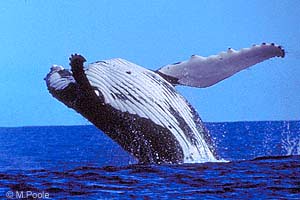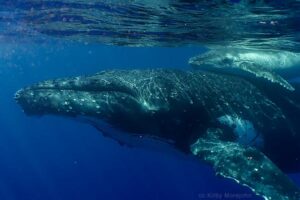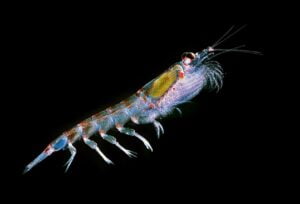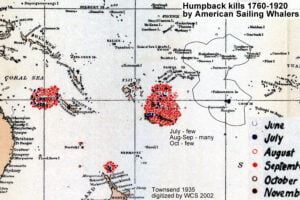Gerald McCormack, CINHT
The dedicated researchers in the South Pacific Whale Research Consortium, including Nan Hauser, have made a large contribution to the recent explosion of information about Humpback Whales. Although science is always a “work in progress” this seems like a good time to review 34 papers up to 2014.
Humpback vitals
The vernacular name humpback refers to the arching of the back as they dive. The unusual Latin name, Megaptera novaeangliae translates to “big-wings of New England”. They were first described around 1750 as the “baleen whale of New England” after the area where they were common, along the northeast coast of the US. A hundred years later, around 1850 they were separated from the other baleen whales and given the name Megaptera or “big wings”, because of their unusually long pectoral fins.
At birth humpbacks are about 4.5m and weigh around one tonne. They feed on mother’s milk for about six months, then increasingly feed themselves on krill, and are weaned at about a year. Females mature at about five years and eventually reach an average of 15 metres and 35 tonnes; males are usually around 14 metres. Females breed every 2-3 years and pregnancies last about 11 months. They can live 50-100 years.
Humpbacks are famous for their long migrations between summer feeding areas around Antarctica and winter breeding areas in the subtropics, about 5,000km apart. At a typical migration rate of 3-6km/hr or 70-140km/day (Horton et al. 2011) it takes them 35-70 days to cover the 5,000km. For comparison, people typically walk at about 5km/hr, about the same speed as whales migrate.
Around Antarctica they feed on tiny shrimp-like animals called krill that form immense swarms, and adult whales can consume about 1.5 tonnes-a-day. During this time they develop an immense layer of fatty tissue known as blubber upon which they live during the 6-8 months of migration and breeding.
In their subtropical breeding grounds humpbacks are famous for their spectacular leaping out of the water (“breaching”) and for the long songs of the males.
Yankee whalers
Life in the Cook Islands was transformed by the non-sectarian London Missionary Society missionaries arriving in the 1820s with the Gospel and a plethora of new plants and animals.
They encouraged people to raise the new crops and animals to sell to visiting ships and traders. In addition to provisioning the whaling ships, young men often joined as replacement crew. Rarotonga sailors were tattooed with the Rau Teve pattern on the side of their necks so they could recognise each other in distant places.
The main islands for provisioning were Rarotonga and Aitutaki. Richards (2014) reported that Yankee whalers called at Rarotonga as follows: one (1820s), 16 (’30s), 82 (’40s), 134 (’50s), 39 (’60s), 13 (’70s), 7 (’80s) and none thereafter. The analysis was based on a partial collection of logbooks and Richards concluded that the actual number of visiting whalers was probably 2-3 times greater.
These whalers were known as Yankee whalers because they came from coastal towns in the New England area, especially from Nantucket and New Bedford in Massachusetts.
Yankee whaling began around 1650 killing Right and Humpback Whales feeding near the New England coast. A Sperm Whale was killed in 1712 and the superior “sperm oil” from its blubber and the much-prized spermaceti or “head oil” lead to whalers sailing further and further to find them.
By 1780 they were whaling everywhere in the north and south Atlantic, along with a few British whalers. They entered the Pacific around 1790 and within a few years were whaling throughout the ocean, except around Antarctica which was too cold and inhospitable.
The Yankee whaling industry peaked around 1850 when there were about 740 ships under the US flag. The industry went into steady decline after about 1860 and finished around 1920.
Townsend’s (1935) analysis of whaler logbooks showed that between Fiji and French Polynesia they killed very few Sperm Whales, and humpbacks as follows: two in Fiji; none in Samoa; 297 in Tonga; three in Cook Islands; and none in the Societies. He analyzed about 10% of the voyages and concluded that actual kills were probably 5-10 times more than shown. He also found that nearly all the humpbacks were killed in August and September. See Figure 1.
The relative number of whales killed in each area is particularly interesting because it provides the earliest data on the distribution of humpback across the South Pacific. It is very obvious that they bred mainly around Tonga and rarely elsewhere.
Smith et al. (2006) re-analyzed Townsend’s data and other information to discover that all whaling in Tonga occurred within the ten years of the 1870s and they estimated that about 2,837 whales were killed. Humpbacks were a last resort for the Yankee whalers because the blubber gave the least valuable whale oil, they were relatively fast and difficult to catch, and they often sank before they could be secured.
As a result of Yankee whaling there was a development of shore-based whaling in Tonga and the Cook Islands. It is not known when it started in the Cook Islands. Powell (1979) reported that the last whale killed on Rarotonga was in 1914 by a gang working for Makea Nui Tinirau Ariki.
This might be mistaken, because the PIM 1930 reported that “Recently there have been numerous whales … and the natives spent endless hours chasing after them….. with no luck but on two occasions managed to scratch the whales with harpoons. However, Aitutaki natives …. landed two whales…” (PIM 1930Dec. v.1(5):9). It is not known when local whaling ceased, although there was no further mention of whaling in 1930s PIM.
The July onset of flowering of the indigenous Ngatae or Coral Tree (Erythrina variegata) was the sign to prepare the equipment and put lookouts on the hills. Upon sighting a whale or To’ōra the lookouts blew their Pū or Triton Conch (Charonia tritonis) trumpets and the rowboats were launched. Whale carcasses were brought ashore into Ngātangi’ia Harbour where the blubber was cooked in large metal pots to extract the oil, which was put in wooden barrels for export.
In Tonga the industry started in the 1890s in the Ha‘apai Group using locally constructed longboats; the oil was sold to trading ships. In 1912 the operation moved to Tongatapu where Tongans soon developed a taste for whale meat and this became the main focus of the industry. (Reeves 2002)
During the 1950s and ’60s they were taking 10-20 whales-a-year, and in the 1970s eleven small operators were taking 3-8 whales-a-year. The industry was banned under the Whaling Act 1979, pending an improved stock assessment. Today, Tonga has a significant whale watching industry, which includes swimming with whales.
Tonga, Cook Islands and French Polynesia
In the last twenty years there has been great progress on monitoring whales with photographic and genetic identification and satellite tracking. These tools have enabled scientists to learn much more about whales moving between island groups, both within breeding seasons and between breeding seasons.
Resighting data to 2004 enabled it to be estimated that Tonga had about 2,300 whales, and French Polynesia about 1,000. At that stage, Cook Islands had no resightings and therefore no population estimate (Baker et al. 2006). The authors concluded that the Cook Islands was “not a primary migratory destination, but rather a part of a migratory corridor used by one or more breeding stocks”.
Genetic research in 2007 (Olavarria et al.) showed Cook Islands whales to be nearly indistinguishable from those of Tonga. In 2007 the six Rarotonga whales with satellite tags all departed to the west or northwest (Hauser et al. 2010, Horton et al. 2011), which further supported the idea that Cook Islands’ whales are part of the Tonga group. In 1993 one whale was recorded in Mo‘orea and a month later in Palmerston which showed that sometimes whales move direct from French Polynesia to the Cook Islands (Poole 2006). See Figure 2.
To 2015, after eighteen years of monitoring, there had been only two resightings in the Cook Islands (Hauser, unpublished), which showed that whales rarely reuse the corridor.
The 2009 (Albertson-Gibb et al.) estimate for French Polynesia was 850-1,850 whales. The sub-stock is genetically distinct (Olavarria et al. 2007) with occasional sharing with other sub-stocks to the west. There has been one intra-seasonal match to the Cook Islands in 1993, and several inter-seasonal matches: Tonga (5), American Samoa (2), and New Caledonia (1) (Poole 2006). The whales of French Polynesia are most common in the Societies and northern Australs, less common in the Tuamotus and very rare in the Marquesas (Poole pers.comm.). The occurrence of this large population in French Polynesia was unexpected considering the lack of whales killed in the area by the Yankee whalers, even though they often provisioned their ships in Tahiti.
Contact Cook Island Natural Heritage Trust for full Bibliography.
















… [Trackback]
[…] Read More: cinature.org/2024/02/23/cook-islands-humpback-whales-part-1/ […]
… [Trackback]
[…] Find More here to that Topic: cinature.org/2024/02/23/cook-islands-humpback-whales-part-1/ […]
… [Trackback]
[…] Info on that Topic: cinature.org/2024/02/23/cook-islands-humpback-whales-part-1/ […]
… [Trackback]
[…] Read More Info here on that Topic: cinature.org/2024/02/23/cook-islands-humpback-whales-part-1/ […]
… [Trackback]
[…] Information to that Topic: cinature.org/2024/02/23/cook-islands-humpback-whales-part-1/ […]
… [Trackback]
[…] Read More to that Topic: cinature.org/2024/02/23/cook-islands-humpback-whales-part-1/ […]
… [Trackback]
[…] Read More Info here to that Topic: cinature.org/2024/02/23/cook-islands-humpback-whales-part-1/ […]
… [Trackback]
[…] Find More on on that Topic: cinature.org/2024/02/23/cook-islands-humpback-whales-part-1/ […]
… [Trackback]
[…] Here you will find 5245 more Information on that Topic: cinature.org/2024/02/23/cook-islands-humpback-whales-part-1/ […]
… [Trackback]
[…] Read More Information here to that Topic: cinature.org/2024/02/23/cook-islands-humpback-whales-part-1/ […]
… [Trackback]
[…] Find More here to that Topic: cinature.org/2024/02/23/cook-islands-humpback-whales-part-1/ […]
… [Trackback]
[…] Find More Information here to that Topic: cinature.org/2024/02/23/cook-islands-humpback-whales-part-1/ […]
… [Trackback]
[…] Find More Information here on that Topic: cinature.org/2024/02/23/cook-islands-humpback-whales-part-1/ […]
… [Trackback]
[…] Here you will find 39429 additional Information on that Topic: cinature.org/2024/02/23/cook-islands-humpback-whales-part-1/ […]
… [Trackback]
[…] Read More Info here on that Topic: cinature.org/2024/02/23/cook-islands-humpback-whales-part-1/ […]
… [Trackback]
[…] Information on that Topic: cinature.org/2024/02/23/cook-islands-humpback-whales-part-1/ […]
… [Trackback]
[…] Read More to that Topic: cinature.org/2024/02/23/cook-islands-humpback-whales-part-1/ […]
… [Trackback]
[…] Read More on that Topic: cinature.org/2024/02/23/cook-islands-humpback-whales-part-1/ […]
… [Trackback]
[…] Here you will find 94179 additional Info to that Topic: cinature.org/2024/02/23/cook-islands-humpback-whales-part-1/ […]
… [Trackback]
[…] Information to that Topic: cinature.org/2024/02/23/cook-islands-humpback-whales-part-1/ […]
… [Trackback]
[…] Info on that Topic: cinature.org/2024/02/23/cook-islands-humpback-whales-part-1/ […]
… [Trackback]
[…] Find More on that Topic: cinature.org/2024/02/23/cook-islands-humpback-whales-part-1/ […]
… [Trackback]
[…] Find More to that Topic: cinature.org/2024/02/23/cook-islands-humpback-whales-part-1/ […]
… [Trackback]
[…] Information on that Topic: cinature.org/2024/02/23/cook-islands-humpback-whales-part-1/ […]
… [Trackback]
[…] Find More on to that Topic: cinature.org/2024/02/23/cook-islands-humpback-whales-part-1/ […]
… [Trackback]
[…] Information on that Topic: cinature.org/2024/02/23/cook-islands-humpback-whales-part-1/ […]
… [Trackback]
[…] Find More to that Topic: cinature.org/2024/02/23/cook-islands-humpback-whales-part-1/ […]
… [Trackback]
[…] Find More Info here on that Topic: cinature.org/2024/02/23/cook-islands-humpback-whales-part-1/ […]
… [Trackback]
[…] Read More on that Topic: cinature.org/2024/02/23/cook-islands-humpback-whales-part-1/ […]
… [Trackback]
[…] Here you can find 97361 more Information to that Topic: cinature.org/2024/02/23/cook-islands-humpback-whales-part-1/ […]
… [Trackback]
[…] Information to that Topic: cinature.org/2024/02/23/cook-islands-humpback-whales-part-1/ […]
… [Trackback]
[…] Find More here on that Topic: cinature.org/2024/02/23/cook-islands-humpback-whales-part-1/ […]
… [Trackback]
[…] Read More Information here on that Topic: cinature.org/2024/02/23/cook-islands-humpback-whales-part-1/ […]
… [Trackback]
[…] Find More Information here on that Topic: cinature.org/2024/02/23/cook-islands-humpback-whales-part-1/ […]
… [Trackback]
[…] Find More on that Topic: cinature.org/2024/02/23/cook-islands-humpback-whales-part-1/ […]
… [Trackback]
[…] Read More to that Topic: cinature.org/2024/02/23/cook-islands-humpback-whales-part-1/ […]
… [Trackback]
[…] Here you can find 24243 additional Info on that Topic: cinature.org/2024/02/23/cook-islands-humpback-whales-part-1/ […]
… [Trackback]
[…] Find More here to that Topic: cinature.org/2024/02/23/cook-islands-humpback-whales-part-1/ […]
… [Trackback]
[…] Read More Information here on that Topic: cinature.org/2024/02/23/cook-islands-humpback-whales-part-1/ […]
… [Trackback]
[…] Information to that Topic: cinature.org/2024/02/23/cook-islands-humpback-whales-part-1/ […]
… [Trackback]
[…] Read More Info here to that Topic: cinature.org/2024/02/23/cook-islands-humpback-whales-part-1/ […]
… [Trackback]
[…] Info to that Topic: cinature.org/2024/02/23/cook-islands-humpback-whales-part-1/ […]
… [Trackback]
[…] Here you will find 34972 additional Information to that Topic: cinature.org/2024/02/23/cook-islands-humpback-whales-part-1/ […]